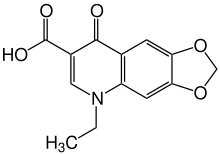Oxolinic acid
Oxolinic acid is a quinolone antibiotic developed in Japan in the 1970s.[1][2] Dosages 12–20 mg/kg orally administered for five to ten days. The antibiotic works by inhibiting the enzyme DNA gyrase. It also acts as a dopamine reuptake inhibitor and has stimulant effects in mice.[3]
 | |
| Clinical data | |
|---|---|
| AHFS/Drugs.com | International Drug Names |
| ATC code | |
| Identifiers | |
| |
| CAS Number | |
| PubChem CID | |
| ChemSpider | |
| UNII | |
| KEGG | |
| ChEBI | |
| ChEMBL | |
| CompTox Dashboard (EPA) | |
| ECHA InfoCard | 100.035.213 |
| Chemical and physical data | |
| Formula | C13H11NO5 |
| Molar mass | 261.233 g·mol−1 |
| 3D model (JSmol) | |
| |
| |
| | |
See also
References
- JP Patent 49138244
- Gleckman R, Alvarez S, Joubert DW, Matthews SJ (August 1979). "Drug therapy reviews: oxolinic acid". American Journal of Hospital Pharmacy. 36 (8): 1077–9. PMID 384788.
- Garcia de Mateos-Verchere J, Vaugeois JM, Naudin B, Costentin J (December 1998). "Behavioural and neurochemical evidence that the antimicrobial agent oxolinic acid is a dopamine uptake inhibitor". European Neuropsychopharmacology. 8 (4): 255–9. doi:10.1016/S0924-977X(97)00083-7. PMID 9928913.
This article is issued from Wikipedia. The text is licensed under Creative Commons - Attribution - Sharealike. Additional terms may apply for the media files.